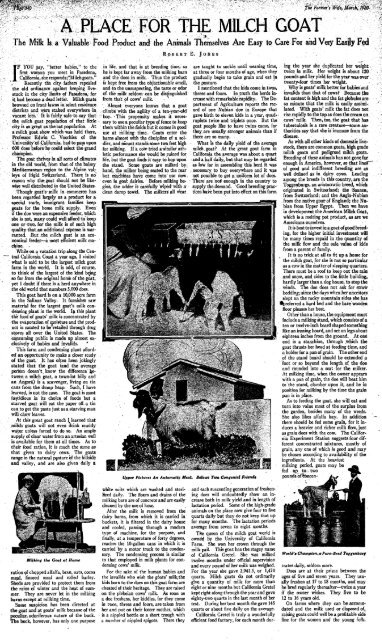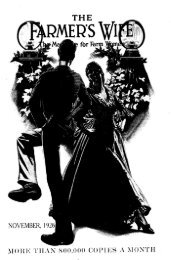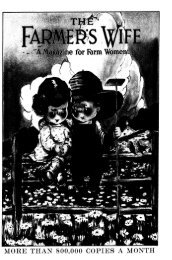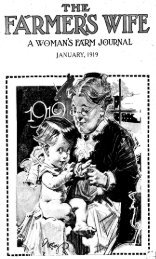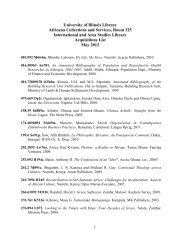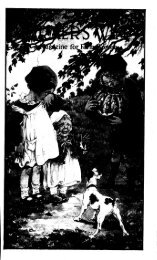H - University of Illinois
H - University of Illinois
H - University of Illinois
Create successful ePaper yourself
Turn your PDF publications into a flip-book with our unique Google optimized e-Paper software.
A FLACE FOR THE MILCH GOAT<br />
The Milk Is a Valuable Food Product and the Animals Themselves Are Easy to Care For and Very Easfly Fed<br />
R OBERT E. J ONES<br />
YOU say, "better babies," to the<br />
IF first woman you meet in Pasedena,<br />
California, she responds;"Milch goats."<br />
, ¦ •;." Recently the city fathers repealed<br />
the old ordinance against keeping livestock<br />
in the city limits <strong>of</strong> Pasadena,' for<br />
it had become a dead letter. Milch goats<br />
browsed on front lawns in select residence<br />
districts and were, staked everywhere in<br />
vacant lots. ' It is fairly safe to say that<br />
the milch goat population <strong>of</strong> that little<br />
city is as great as the cat population. . At<br />
a milch goat, show which was held there,<br />
Pr<strong>of</strong>essor. Edwin C. Voorhies <strong>of</strong> the<br />
<strong>University</strong> <strong>of</strong> California, had to pass upon<br />
600 does before he could select the grand<br />
champion.<br />
The goat thrives in all sorts <strong>of</strong> climates<br />
in the old world, from that <strong>of</strong> the balmy<br />
Mediterranean region to the Alpine valleys<br />
<strong>of</strong> frigid Switzerland. There is no<br />
reason why the-, goat should not be likewise<br />
well distributed in the United States.<br />
Though- goat's- milk in commerce has<br />
been regarded largely as a product for a<br />
special trade, immigrant families keep<br />
goats for the home milk supply. Even<br />
if the:doe were an expensive feeder, which<br />
she is not, many could well afford to keep<br />
one or two, for the milk is <strong>of</strong> such high<br />
quality that, an additional expense is warranted.<br />
-But .the milch goat is an economical<br />
feeder—a most efficient milk machine.<br />
-<br />
While on a vacation trip along the Central<br />
California Coast a year ago, I visited<br />
what is said to be the largest milch goat<br />
farm in the world, It is odd, <strong>of</strong> course,<br />
to think <strong>of</strong> the largest <strong>of</strong> the kind being<br />
so far from the original home <strong>of</strong> the goat,<br />
yet I doubt if there is a herd anywhere in<br />
the old world that numbers 5,000 does.<br />
This goat herd is on a 10,000 acre farm<br />
in the Salinas Valley. It furnishes raw<br />
material for the largest goat's milk condensing<br />
plant in the world. In this plant<br />
the food <strong>of</strong> goats' milk is concentrated by<br />
the evaporation <strong>of</strong> moisture and the 1 product<br />
is canned to oeTetailed through drug<br />
stores all over the United States. The<br />
consuming public is made up almost exclusively<br />
<strong>of</strong> babies and invalids. *<br />
This farm and condensing plant afforded<br />
an opportunity to make a closer study<br />
<strong>of</strong> the goat. It has <strong>of</strong>ten heen jokingly<br />
stated that the goat (and the average<br />
person doesn't, know the difference' between<br />
a milch goat, a town-lot billy and<br />
an Angora) is a scavenger, living on tin<br />
cans from the dump heap. Such, I have<br />
learned; is not the case. The goat is most<br />
fastidious in its choice <strong>of</strong> foods but a<br />
starved goat will eat the paper <strong>of</strong>f- a tin<br />
can to get the paste just as a starving man<br />
will chew leaves.<br />
At this great goat ranch \ learned that<br />
milch goats will not even drink muddy<br />
water unless forced to do so. An ample<br />
supply <strong>of</strong> clear water from an artesian well<br />
is available for them at all times. As to<br />
their food ration, it is much the same as<br />
that given to dairy cows. The goats<br />
range in the natural pasture <strong>of</strong> the hillside<br />
and valley, and are also given daily a<br />
in life, and that is at breeding time,- so<br />
he is kept far away from the milking barn<br />
and the'does .in milk, - Thus the product<br />
is kept free from the objectionable smell,<br />
and to the unsuspecting, the taste or odor<br />
<strong>of</strong> the milk seldom can. be distinguished<br />
from that <strong>of</strong> cows' milk. -<br />
Almost everyone knows that a goat<br />
climbs with the agility <strong>of</strong> a ten-year-old<br />
boy. --This propensity makes it necessary<br />
to use a peculiar type <strong>of</strong> fence to keep<br />
them within the fields but it comes in good<br />
use at milking time. . Goats enter the<br />
barns almost with the discipline <strong>of</strong> a soldier,<br />
and mount stands some two feet high<br />
for milking. If a cow tried a-similar athletic<br />
performance she'would be ruined for<br />
life, but the goat finds it easy to hop upon<br />
the stand. Some goats are milked byhand,<br />
the milker being seated to the real 1<br />
but machines have come into use now<br />
even in goat dairies. Before milking begins,<br />
the udder is carefully 'wiped' with a'<br />
clean damp towel. The milkers" all wear<br />
are taught to suckle until weaning time,<br />
at three or four months <strong>of</strong> age, when they<br />
gradually begin to take grain and eat in<br />
the pasture.<br />
I mentioned that the kids come in twos,<br />
threes and fours. Injruth the herds increase<br />
with remarkable rapidity. The Department<br />
<strong>of</strong> Agriculture reports the record<br />
<strong>of</strong> one Nubian doe in Europe that<br />
gave birth to eleven kids in a year, quadruplets<br />
twice and triplets once. But the<br />
goat people like to have twins come, for<br />
they„are usually stronger animals than if<br />
there are so many.<br />
What is the daily yield <strong>of</strong> the average<br />
milch , goat? At the great goat farm in<br />
California the average was about a quart<br />
- and a half daily, but that may be regarded<br />
as low for in assembling this herd it was<br />
- necessary, to buy everywhere and it was<br />
not possible to get a.uniform lot <strong>of</strong> does.<br />
There are h<strong>of</strong> enough in the country to<br />
supply the. demand. ; Good breeding practices<br />
have been put into effect on this farm<br />
Upper Picture. An Automatic Meal. Below) Two Congenial Friends<br />
ing the year she duplicated her weight •<br />
twice in milk. Her weight is about 120 .<br />
pounds and her yield for the year was over .<br />
twenty-four times her weight.<br />
Why is goats' milk better for babies and<br />
invalids than that <strong>of</strong> cows? Because the<br />
fat content is high and the fat globules are<br />
so minute that the milk is easily assimilated.<br />
With goats' milk the fat does not<br />
rise rapidly to the top as does the cream on<br />
cows' milk. Then, too, the goat that has<br />
tuberculosis is a rare creature—some.authorities<br />
say that she is immune from the<br />
disease.<br />
As with all other kinds <strong>of</strong> domestic livestock,<br />
there are common goats, high grade<br />
milch goats and pedigreed milch goats.<br />
Breeding <strong>of</strong> these animals has not gone far<br />
enough in America, however, so that lines"<br />
<strong>of</strong> good and indifferent breeding are as<br />
well defined as in dairy cows. Leading<br />
among the breeds in this country, ace, the<br />
Toggenburgs, an aristocratic breed, which<br />
originated in Switzerland; the Saanen,<br />
from Switzerland; and the Anglo-Nubian<br />
from the native goat <strong>of</strong> England; the Nubian<br />
from Upper Egypt. Then we have<br />
in development the American Milch Goat,<br />
which is a melting pot product, as are we<br />
Americans ourselves.<br />
It is best to invest in a goat <strong>of</strong> good breeding,<br />
for the higher initial investment will<br />
be many times repaid in the quantity <strong>of</strong><br />
the milk flow and the sale value <strong>of</strong> kids<br />
from a parent <strong>of</strong> family.<br />
It is no trick at all to fit up a home for<br />
the milch goat, for she is not so particular<br />
as a cow in the matter <strong>of</strong> sleeping quarters.<br />
There must be a ro<strong>of</strong> to keep out the rain<br />
and snow, and sides to the little building,<br />
hardly larger than a dog house, to stop the<br />
winds. The doe does not ask for straw<br />
bedding; since the days when her ancestors<br />
slept on the rocky mountain sides she has<br />
preferred a hard bed and the bare wooden<br />
floor pleases her best.<br />
Other than a house, the equipment must<br />
include a milking stand, which consists <strong>of</strong> a<br />
ten or twelve-inch board shaped something<br />
like an ironing board, and set on legs about<br />
eighteen inches from the ground. At one<br />
end is a stanchion, through .which the<br />
goat thrusts her head at feeding time, and<br />
a holder for a pan <strong>of</strong> grain. The other end<br />
<strong>of</strong> the stand board should be extended a<br />
foot or so beyond the length <strong>of</strong> the doe<br />
and rounded into a seat for the milker.<br />
At milking time, when the owner appears<br />
with a pan <strong>of</strong> grain, the doe will beat him<br />
to the stand, clamber upon it, and be in<br />
position for milking by the time the grain<br />
pan is in place.<br />
As to feeding the goat, she will eat and<br />
turn into value most <strong>of</strong> the surplus from<br />
the garden, besides many <strong>of</strong> the weeds.<br />
She also likes alfalfa hay. In addition<br />
there should be fed some grain, for it induces<br />
a heavier and richer milk flow, just<br />
as grain does with the cow. The California<br />
Experiment Station suggests four different<br />
concentrated mixtures, mostly <strong>of</strong><br />
grain, any one <strong>of</strong> which is good and may<br />
be chosen according to availability <strong>of</strong> the<br />
ingredients. At the heaviest<br />
milking period, goats may be M-\<br />
fed up to- two<br />
iBL<br />
pounds bffeaicen- g\* l^T<br />
Milking the Goat at Home<br />
ration <strong>of</strong> chopped alfalfa, bran, oats, cocoa<br />
me>I, linseed meal and rolled barley.<br />
Sheds are provided to protect them from<br />
the rains <strong>of</strong> winter and the heat <strong>of</strong> summer.<br />
They are never let in the milking<br />
barns except at milking time.<br />
Some suspicion has been directed at<br />
the goat and at goats' milk because <strong>of</strong> the<br />
peculiar, odoriferous nature <strong>of</strong> the buck.<br />
The buck, however, has only one purpose<br />
white suits which are washed and sterilized<br />
daily. The floors and drains <strong>of</strong> the<br />
milking barn are <strong>of</strong> concrete and are easily<br />
cleaned by the use <strong>of</strong> hose.<br />
After the milk is removed from the<br />
dairy barns, from which it is carried in<br />
buckets, it is filtered in the dairy house<br />
and cooled, passing through a modern<br />
type <strong>of</strong> machine, for the purpose, and<br />
finally, at a temperature <strong>of</strong> forty degrees,<br />
reaches the 10-gallon cans in which it is<br />
carried by a motor truck to the condensory.<br />
The condensing process is similar<br />
to that employed in milk plants for condensing<br />
cows' milk.<br />
For the sake <strong>of</strong> the human babies and<br />
the invalids who wish the goats' milk,the<br />
kids born to the does on this goat farm are<br />
cheated <strong>of</strong> their heritage. They are raised<br />
on the plebeian cows' milk. As soon as<br />
a doe freshens, her kiddies, for they come<br />
in twos, threes and fours, are taken from<br />
her and put on their foster mother, which<br />
is a nippled bottle or a short trough with<br />
a number <strong>of</strong> nippled spigots. There they<br />
and each succeeding generation <strong>of</strong> freshening<br />
does will undoubtedly show an increase<br />
both in milk yield and in length <strong>of</strong><br />
lactation period. Some <strong>of</strong> the high-grade<br />
animals on the place now give four to five<br />
quarts daily but they do not keep that up<br />
for many months. The lactation periods<br />
average from seven to eight months.<br />
The queen <strong>of</strong> the milch goat world is<br />
owned by the <strong>University</strong> <strong>of</strong> California<br />
Farm. She won her crown through the<br />
milk pail. This goat has the stagey name<br />
<strong>of</strong> California Gretel. She was milked<br />
twelve- months under <strong>of</strong>ficial .supervision<br />
and every pound <strong>of</strong> her milk was weighed.<br />
For the year she gave 2,941.5, or 1,470<br />
quarts. Milch goats do not ordinarily<br />
give a quantity <strong>of</strong> milk for more than<br />
eight or nine months but California Gretel<br />
kept right along through the year and gave<br />
eighty-two quarts in the last month <strong>of</strong> her<br />
test. During her best month she gave 145<br />
quarts or about five daily on the average.<br />
California Gretel is truly a wonderfully<br />
efficient food factory, for each month dur-<br />
World's Champion,a Pure-Bred Toggenburg<br />
trates daily, seldom more.<br />
Does are at their prime between the<br />
ages <strong>of</strong> five and seven years. They usually<br />
freshen at 17 to 18 months, and may<br />
be bred regularly thereafter—twice a year<br />
if the owner wishes. They live to be<br />
12 to 16 years old.<br />
On farms where they can be accomodated<br />
and the milk used or disposed <strong>of</strong>,<br />
raising goats could well be a pr<strong>of</strong>itable side<br />
line for the women and the young folk.


